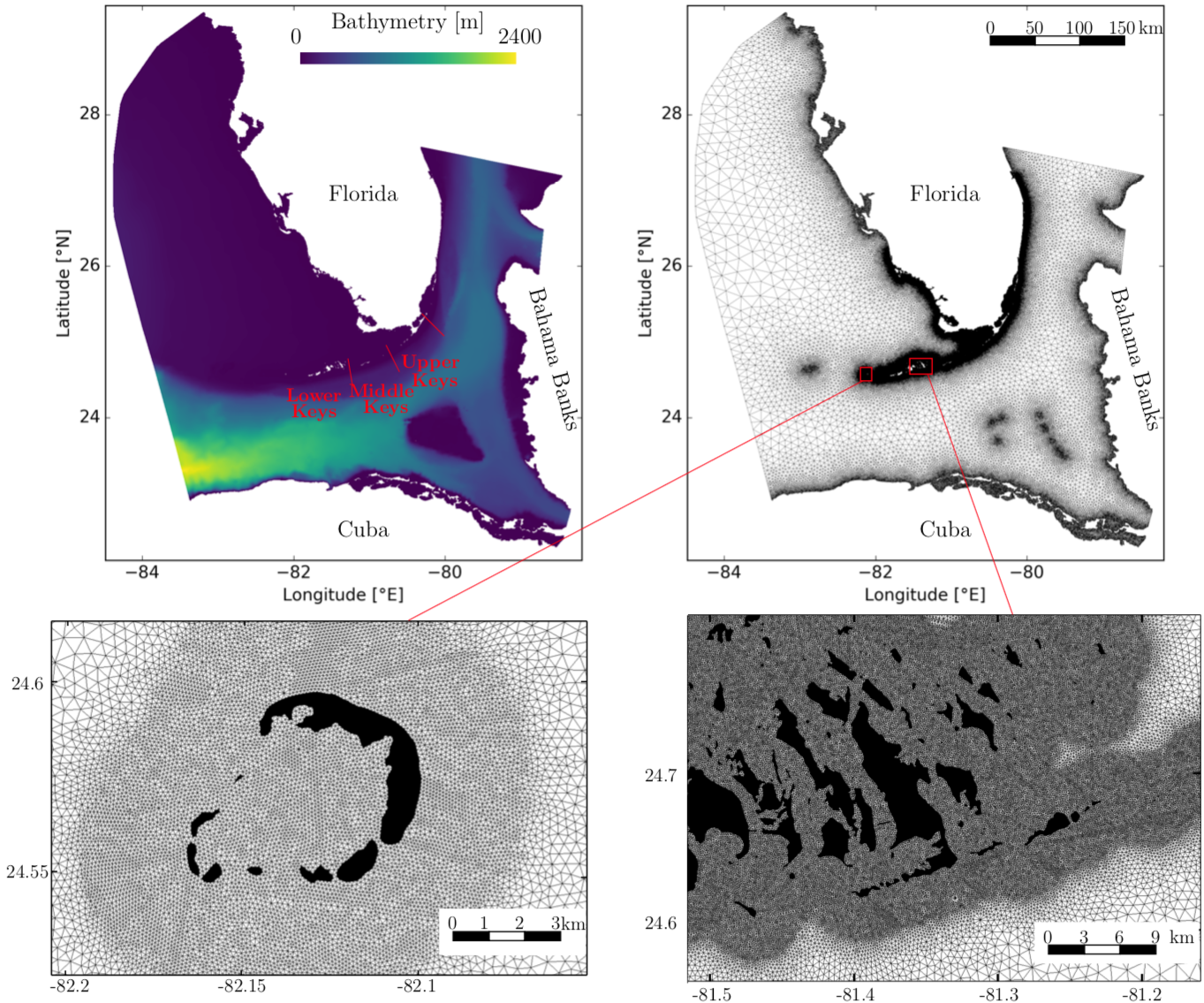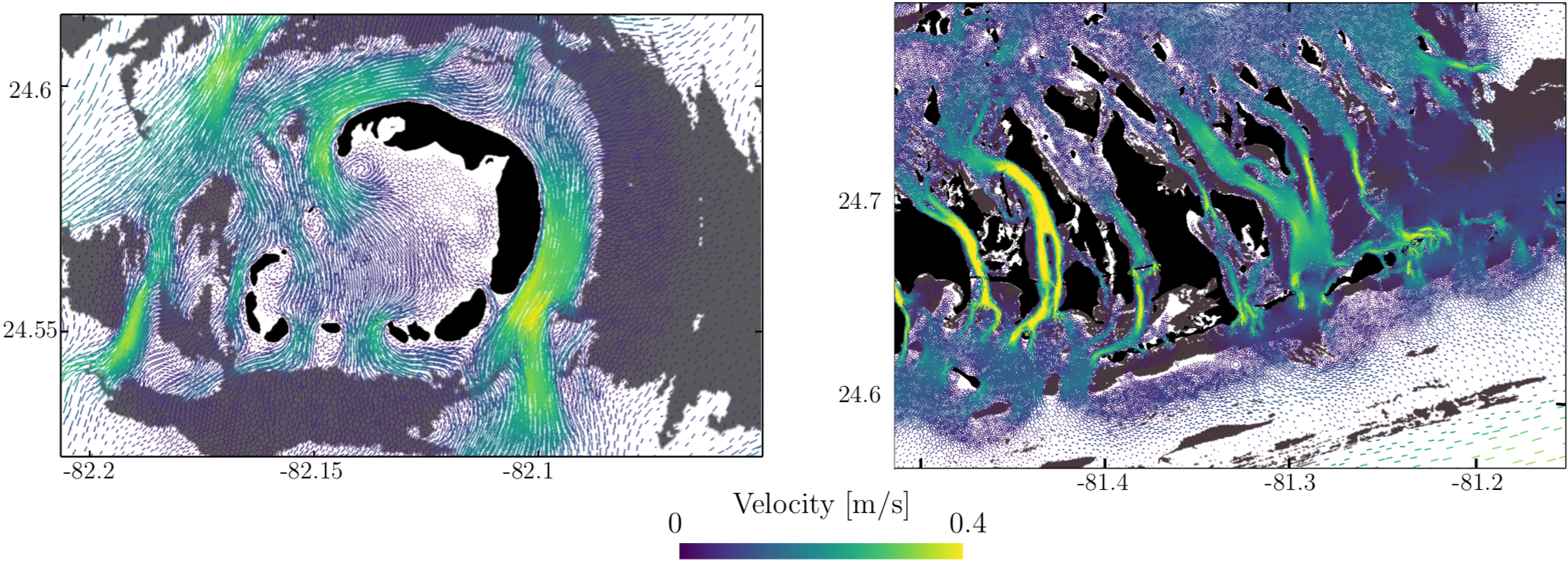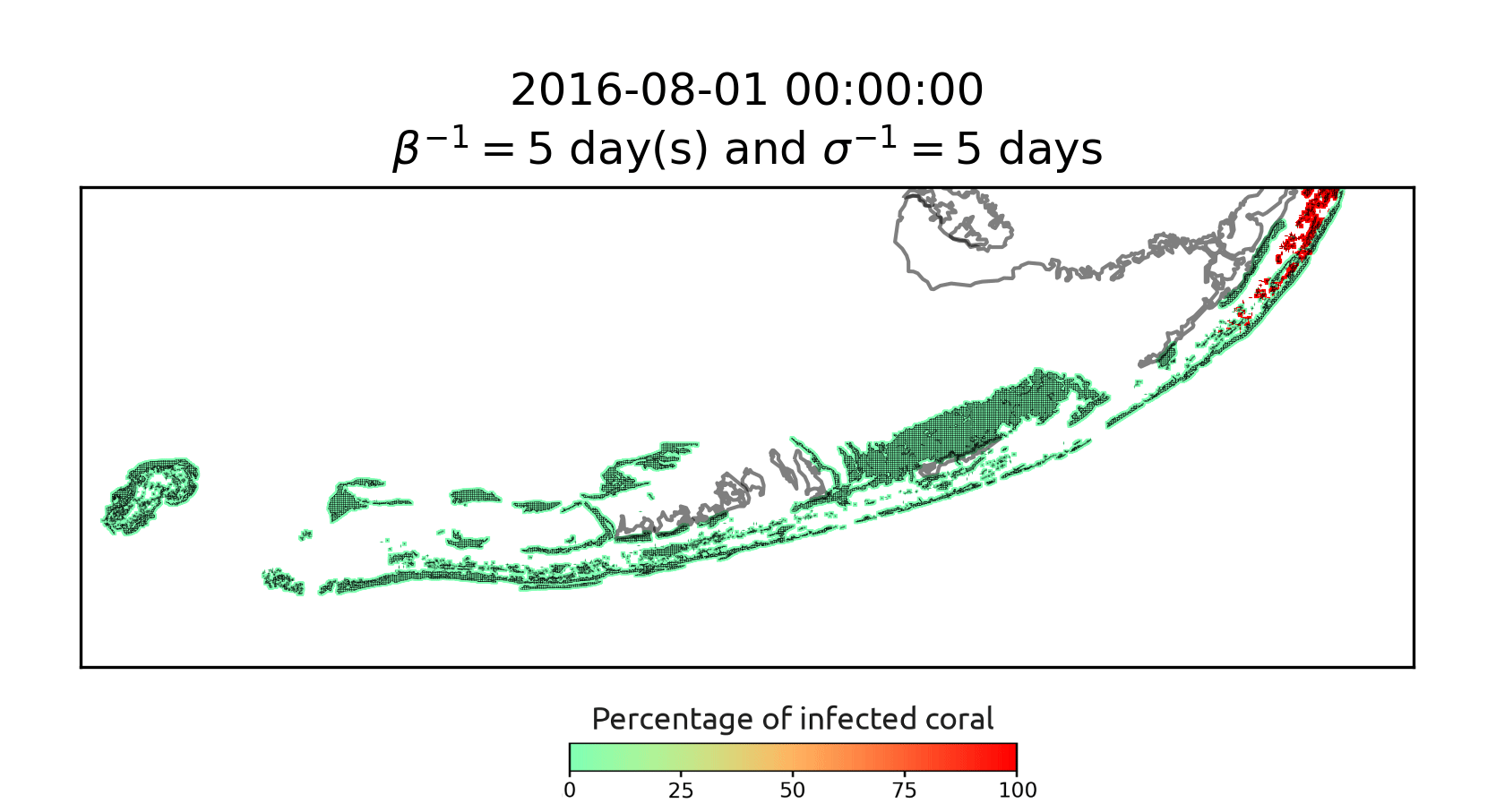The Florida Reef Tract (FRT) spans over 580km from the Dry Tortugas National Park west of the Florida Keys to the St. Lucie Inlet in Martin County, constituting the third largest barrier reef in the world. It is located along the northern side of the Straits of Florida that connect the Gulf of Mexico and the North Atlantic Ocean. The ocean circulation of that region is dominated by the Florida Current, which is an intense western boundary current that continues the Loop Current inside the Gulf of Mexico and, downstream, forms the Gulf Stream. Here, we try to estimate larval dispersal and connectivity of Montastraea cavernosa between the ~1000 reefs composing the FRT. We use SLIM2D with a mesh resolution ranging from about 100m near the reefs to 15km faraway from the FRT.
Using such a fine mesh resolution, we can explicitly simulate fine-scale details of the flow such as recirculation eddies and currents within the dense reef system in the Lower Keys that consists of many individual reefs with narrow passages in between. In the deeper ocean, SLIM is coupled with the large-scale ocean model HYCOM in order to correctly represent the Florida Current.
We then use the Lagrangian particle tracker to simulate the transport of larvae between all the reefs in the FRT. The larval dynamics is driven by the simulated currents and by experimentally-measured life history traits such as mortality, competence and settlement behaviour. We have seeded larvae on all the reefs composing the FRT in order to estimate the potential connections between them as would happen if each reef had the same coral density and enough room to accommodate all settlers. The video below highlights the fine details of larval transport in Lower Keys and shows that larvae can be transported by tidal currents from the inner-shelf to the outer-shelf region.
VIDEO
The Lagrangian particle tracker can also be used to simulate the transport of materials (coral mucus, sediments, pelagic organisms, etc.) potentially carrying the causative agent of the Stony Coral Tissue Loss Disease through the FRT. The connectivity results of the particle tracker are then coupled with an epidemiological model in order to reproduce the observed propagation of the outbreak in an attempt to deduce the characteristics of the (yet to be identified) causative agent of the disease and its potential vector.
External collaborators
Dr. Joana Figueiredo (Nova Southeastern University), Dr. Lew Gramer (NOAA and University of Miami), Dr. Matthieu Le Hénaff (NOAA and University of Miami), Dr. Dan Holstein (Louisiana State University) and Dr. Erinn Muller (Mote Marine Laboratory).
To learn more…
778265
FRT
1
apa
50
date
desc
4683
https://www.slim-ocean.be/wp-content/plugins/zotpress/
%7B%22status%22%3A%22success%22%2C%22updateneeded%22%3Afalse%2C%22instance%22%3Afalse%2C%22meta%22%3A%7B%22request_last%22%3A0%2C%22request_next%22%3A0%2C%22used_cache%22%3Atrue%7D%2C%22data%22%3A%5B%7B%22key%22%3A%229GBCLPET%22%2C%22library%22%3A%7B%22id%22%3A778265%7D%2C%22meta%22%3A%7B%22creatorSummary%22%3A%22Hirsh%20et%20al.%22%2C%22parsedDate%22%3A%222025%22%2C%22numChildren%22%3A1%7D%2C%22bib%22%3A%22%26lt%3Bdiv%20class%3D%26quot%3Bcsl-bib-body%26quot%3B%20style%3D%26quot%3Bline-height%3A%202%3B%20padding-left%3A%201em%3B%20text-indent%3A-1em%3B%26quot%3B%26gt%3B%5Cn%20%20%26lt%3Bdiv%20class%3D%26quot%3Bcsl-entry%26quot%3B%26gt%3BHirsh%2C%20H.%20K.%2C%20Oliver%2C%20T.%20A.%2C%20Dobbelaere%2C%20T.%2C%20Palacio-Castro%2C%20A.%20M.%2C%20Barkley%2C%20H.%20C.%2C%20Webb%2C%20A.%20E.%2C%20Hanert%2C%20E.%2C%20%26amp%3B%20Enochs%2C%20I.%20C.%20%282025%29.%20Statistical%20Prediction%20of%20In%20Situ%20Coral%20Reef%20Carbonate%20Dynamics%20Using%20Endmember%20Chemistry%2C%20Hydrodynamic%20Models%2C%20And%20Benthic%20Composition.%20%26lt%3Bi%26gt%3BAquatic%20Geochemistry%26lt%3B%5C%2Fi%26gt%3B%2C%20%26lt%3Bi%26gt%3B31%26lt%3B%5C%2Fi%26gt%3B%281%29%2C%204.%20%26lt%3Ba%20class%3D%26%23039%3Bzp-DOIURL%26%23039%3B%20href%3D%26%23039%3Bhttps%3A%5C%2F%5C%2Fdoi.org%5C%2F10.1007%5C%2Fs10498-025-09438-x%26%23039%3B%26gt%3Bhttps%3A%5C%2F%5C%2Fdoi.org%5C%2F10.1007%5C%2Fs10498-025-09438-x%26lt%3B%5C%2Fa%26gt%3B%26lt%3B%5C%2Fdiv%26gt%3B%5Cn%26lt%3B%5C%2Fdiv%26gt%3B%22%2C%22data%22%3A%7B%22itemType%22%3A%22journalArticle%22%2C%22title%22%3A%22Statistical%20Prediction%20of%20In%20Situ%20Coral%20Reef%20Carbonate%20Dynamics%20Using%20Endmember%20Chemistry%2C%20Hydrodynamic%20Models%2C%20And%20Benthic%20Composition%22%2C%22creators%22%3A%5B%7B%22creatorType%22%3A%22author%22%2C%22firstName%22%3A%22Heidi%20K.%22%2C%22lastName%22%3A%22Hirsh%22%7D%2C%7B%22creatorType%22%3A%22author%22%2C%22firstName%22%3A%22Thomas%20A.%22%2C%22lastName%22%3A%22Oliver%22%7D%2C%7B%22creatorType%22%3A%22author%22%2C%22firstName%22%3A%22Thomas%22%2C%22lastName%22%3A%22Dobbelaere%22%7D%2C%7B%22creatorType%22%3A%22author%22%2C%22firstName%22%3A%22Ana%20M.%22%2C%22lastName%22%3A%22Palacio-Castro%22%7D%2C%7B%22creatorType%22%3A%22author%22%2C%22firstName%22%3A%22Hannah%20C.%22%2C%22lastName%22%3A%22Barkley%22%7D%2C%7B%22creatorType%22%3A%22author%22%2C%22firstName%22%3A%22Alice%20E.%22%2C%22lastName%22%3A%22Webb%22%7D%2C%7B%22creatorType%22%3A%22author%22%2C%22firstName%22%3A%22Emmanuel%22%2C%22lastName%22%3A%22Hanert%22%7D%2C%7B%22creatorType%22%3A%22author%22%2C%22firstName%22%3A%22Ian%20C.%22%2C%22lastName%22%3A%22Enochs%22%7D%5D%2C%22abstractNote%22%3A%22In%20the%20face%20of%20rapidly%20compounding%20climate%20change%20impacts%2C%20including%20ocean%20acidification%20%28OA%29%2C%20it%20is%20critical%20to%20understand%20present-day%20stress%20exposure%20and%20to%20anticipate%20the%20biogeochemical%20conditions%20experienced%20by%20vulnerable%20ecosystems%20like%20coral%20reefs.%20To%20meaningfully%20predict%20nearshore%20carbonate%20chemistry%2C%20we%20must%20account%20for%20the%20complexity%20of%20the%20local%20benthic%20community%2C%20as%20well%20as%20connectivity%20between%20habitats%20and%20relevant%20endmember%20carbonate%20chemistry.%20Here%2C%20we%20adopt%20a%20system-scale%20approach%20to%20predict%20site-scale%20effects%20of%20benthic%20metabolism%20on%20the%20carbonate%20system%20of%20the%20Florida%20Reef%20Tract%20%28FRT%29.%20We%20utilize%20bimonthly%20carbonate%20chemistry%20data%20from%20ten%20cross-shelf%20transects%20spanning%20250%20km%20of%20the%20FRT%20to%20model%20changes%20in%20dissolved%20inorganic%20carbon%20%28DIC%29%20and%20total%20alkalinity%20%28TA%29.%20Benthic%20habitat%20maps%20were%20used%20to%20broadly%20classify%20communities%20known%20to%20impact%20carbonate%20chemistry.%20A%20SLIM%202D%20hydrodynamic%20model%20with%20mesh%20resolution%20reaching%20100%20m%20over%20reefs%20and%20along%20the%20coastline%20was%20used%20to%20determine%20the%20relevant%20water%20mass%20histories%20and%20identify%20the%20upstream%20benthic%20communities%20shaping%20local%20carbonate%20chemistry.%20These%20historical%20metabolic%20footprints%2C%20or%20%5Cu201cflowsheds%5Cu201d%2C%20were%20used%20to%20build%20predictive%20models%20of%20the%20change%20in%20DIC%20and%20TA%20at%20each%20station.%20The%20best%20predictive%20models%20included%20the%20chemical%20impacts%20of%20benthic%20ecosystem%20metabolism%2C%20as%20defined%20by%20water%20mass%20trajectories%2C%20weighted%20endmember%20chemistry%2C%20volume%2C%20time%2C%20and%20other%20environmental%20parameters%20%28light%2C%20temperature%2C%20salinity%2C%20chlorophyll-a%2C%20and%20nitrate%29.%20Considering%20water%20mass%20for%205%20days%20prior%20to%20sample%20collection%20yielded%20the%20highest%20model%20skill.%22%2C%22date%22%3A%2202%5C%2F2025%22%2C%22language%22%3A%22en%22%2C%22DOI%22%3A%2210.1007%5C%2Fs10498-025-09438-x%22%2C%22ISSN%22%3A%221380-6165%2C%201573-1421%22%2C%22url%22%3A%22https%3A%5C%2F%5C%2Flink.springer.com%5C%2F10.1007%5C%2Fs10498-025-09438-x%22%2C%22collections%22%3A%5B%22GJSQZPDC%22%5D%2C%22dateModified%22%3A%222025-02-26T11%3A44%3A54Z%22%7D%7D%2C%7B%22key%22%3A%22IZMKRZRG%22%2C%22library%22%3A%7B%22id%22%3A778265%7D%2C%22meta%22%3A%7B%22creatorSummary%22%3A%22Dobbelaere%20et%20al.%22%2C%22parsedDate%22%3A%222024%22%2C%22numChildren%22%3A1%7D%2C%22bib%22%3A%22%26lt%3Bdiv%20class%3D%26quot%3Bcsl-bib-body%26quot%3B%20style%3D%26quot%3Bline-height%3A%202%3B%20padding-left%3A%201em%3B%20text-indent%3A-1em%3B%26quot%3B%26gt%3B%5Cn%20%20%26lt%3Bdiv%20class%3D%26quot%3Bcsl-entry%26quot%3B%26gt%3BDobbelaere%2C%20T.%2C%20Holstein%2C%20D.%20M.%2C%20Gramer%2C%20L.%20J.%2C%20McEachron%2C%20L.%2C%20%26amp%3B%20Hanert%2C%20E.%20%282024%29.%20Investigating%20the%20link%20between%20the%20Port%20of%20Miami%20dredging%20and%20the%20onset%20of%20the%20stony%20coral%20tissue%20loss%20disease%20epidemics.%20%26lt%3Bi%26gt%3BMarine%20Pollution%20Bulletin%26lt%3B%5C%2Fi%26gt%3B%2C%20%26lt%3Bi%26gt%3B207%26lt%3B%5C%2Fi%26gt%3B%2C%20116886.%20%26lt%3Ba%20class%3D%26%23039%3Bzp-DOIURL%26%23039%3B%20href%3D%26%23039%3Bhttps%3A%5C%2F%5C%2Fdoi.org%5C%2F10.1016%5C%2Fj.marpolbul.2024.116886%26%23039%3B%26gt%3Bhttps%3A%5C%2F%5C%2Fdoi.org%5C%2F10.1016%5C%2Fj.marpolbul.2024.116886%26lt%3B%5C%2Fa%26gt%3B%26lt%3B%5C%2Fdiv%26gt%3B%5Cn%26lt%3B%5C%2Fdiv%26gt%3B%22%2C%22data%22%3A%7B%22itemType%22%3A%22journalArticle%22%2C%22title%22%3A%22Investigating%20the%20link%20between%20the%20Port%20of%20Miami%20dredging%20and%20the%20onset%20of%20the%20stony%20coral%20tissue%20loss%20disease%20epidemics%22%2C%22creators%22%3A%5B%7B%22creatorType%22%3A%22author%22%2C%22firstName%22%3A%22Thomas%22%2C%22lastName%22%3A%22Dobbelaere%22%7D%2C%7B%22creatorType%22%3A%22author%22%2C%22firstName%22%3A%22Daniel%20M.%22%2C%22lastName%22%3A%22Holstein%22%7D%2C%7B%22creatorType%22%3A%22author%22%2C%22firstName%22%3A%22Lewis%20J.%22%2C%22lastName%22%3A%22Gramer%22%7D%2C%7B%22creatorType%22%3A%22author%22%2C%22firstName%22%3A%22Lucas%22%2C%22lastName%22%3A%22McEachron%22%7D%2C%7B%22creatorType%22%3A%22author%22%2C%22firstName%22%3A%22Emmanuel%22%2C%22lastName%22%3A%22Hanert%22%7D%5D%2C%22abstractNote%22%3A%22Since%202014%2C%20the%20stony%20coral%20tissue%20loss%20disease%20%28SCTLD%29%20has%20been%20decimating%20corals%20in%20the%20Caribbean.%20Although%20the%20trigger%20of%20this%20outbreak%20remains%20elusive%2C%20evidence%20suggests%20waterborne%20sediment-mediated%20disease%20transmission.%20The%20outbreak%20reportedly%20initiated%20in%20September%202014%20at%20a%20reef%20site%20off%20Virginia%20Key%20%28VKR%29%2C%20during%20extensive%20dredging%20operations%20at%20the%20Port%20of%20Miami.%20Here%20we%20use%20a%20high-resolution%20ocean%20model%20to%20identify%20the%20potential%20driver%20of%20the%20outbreak%20by%20simulating%20the%20dispersal%20of%20dredged%20sediments%2C%20wastewater%20plumes%20and%20disease%20agents.%20Our%20results%20suggest%20that%20VKR%20could%20have%20been%20impacted%20by%20fine%20sediments%20produced%20by%20dredging%20operations%2C%20especially%20those%20involving%20non-conventional%20rock-chopping%20techniques.%20Wastewater%20contamination%20was%20unlikely.%20Additionally%2C%20our%20connectivity%20analysis%20indicates%20potential%20disease%20transmission%20from%20other%20affected%20reefs%20to%20VKR.%20Our%20results%20therefore%20suggest%20that%20dredging%20operations%20might%20be%20responsible%20for%20the%20onset%20of%20the%20epidemics.%20This%20underscores%20the%20need%20for%20stricter%20operational%20guidelines%20in%20future%20dredging%20projects.%22%2C%22date%22%3A%2210%5C%2F2024%22%2C%22language%22%3A%22en%22%2C%22DOI%22%3A%2210.1016%5C%2Fj.marpolbul.2024.116886%22%2C%22ISSN%22%3A%220025326X%22%2C%22url%22%3A%22https%3A%5C%2F%5C%2Flinkinghub.elsevier.com%5C%2Fretrieve%5C%2Fpii%5C%2FS0025326X24008634%22%2C%22collections%22%3A%5B%22GJSQZPDC%22%5D%2C%22dateModified%22%3A%222024-09-02T09%3A12%3A35Z%22%7D%7D%2C%7B%22key%22%3A%227RAKJ2F9%22%2C%22library%22%3A%7B%22id%22%3A778265%7D%2C%22meta%22%3A%7B%22creatorSummary%22%3A%22Dobbelaere%20et%20al.%22%2C%22parsedDate%22%3A%222024%22%2C%22numChildren%22%3A1%7D%2C%22bib%22%3A%22%26lt%3Bdiv%20class%3D%26quot%3Bcsl-bib-body%26quot%3B%20style%3D%26quot%3Bline-height%3A%202%3B%20padding-left%3A%201em%3B%20text-indent%3A-1em%3B%26quot%3B%26gt%3B%5Cn%20%20%26lt%3Bdiv%20class%3D%26quot%3Bcsl-entry%26quot%3B%26gt%3BDobbelaere%2C%20T.%2C%20Dekens%2C%20A.%2C%20Saint%26%23x2010%3BAmand%2C%20A.%2C%20Alaerts%2C%20L.%2C%20Holstein%2C%20D.%20M.%2C%20%26amp%3B%20Hanert%2C%20E.%20%282024%29.%20Hurricanes%20enhance%20coral%20connectivity%20but%20also%20superspread%20coral%20diseases.%20%26lt%3Bi%26gt%3BGlobal%20Change%20Biology%26lt%3B%5C%2Fi%26gt%3B%2C%20%26lt%3Bi%26gt%3B30%26lt%3B%5C%2Fi%26gt%3B%286%29%2C%20e17382.%20%26lt%3Ba%20class%3D%26%23039%3Bzp-DOIURL%26%23039%3B%20href%3D%26%23039%3Bhttps%3A%5C%2F%5C%2Fdoi.org%5C%2F10.1111%5C%2Fgcb.17382%26%23039%3B%26gt%3Bhttps%3A%5C%2F%5C%2Fdoi.org%5C%2F10.1111%5C%2Fgcb.17382%26lt%3B%5C%2Fa%26gt%3B%26lt%3B%5C%2Fdiv%26gt%3B%5Cn%26lt%3B%5C%2Fdiv%26gt%3B%22%2C%22data%22%3A%7B%22itemType%22%3A%22journalArticle%22%2C%22title%22%3A%22Hurricanes%20enhance%20coral%20connectivity%20but%20also%20superspread%20coral%20diseases%22%2C%22creators%22%3A%5B%7B%22creatorType%22%3A%22author%22%2C%22firstName%22%3A%22Thomas%22%2C%22lastName%22%3A%22Dobbelaere%22%7D%2C%7B%22creatorType%22%3A%22author%22%2C%22firstName%22%3A%22Apolline%22%2C%22lastName%22%3A%22Dekens%22%7D%2C%7B%22creatorType%22%3A%22author%22%2C%22firstName%22%3A%22Antoine%22%2C%22lastName%22%3A%22Saint%5Cu2010Amand%22%7D%2C%7B%22creatorType%22%3A%22author%22%2C%22firstName%22%3A%22Lauranne%22%2C%22lastName%22%3A%22Alaerts%22%7D%2C%7B%22creatorType%22%3A%22author%22%2C%22firstName%22%3A%22Daniel%20M.%22%2C%22lastName%22%3A%22Holstein%22%7D%2C%7B%22creatorType%22%3A%22author%22%2C%22firstName%22%3A%22Emmanuel%22%2C%22lastName%22%3A%22Hanert%22%7D%5D%2C%22abstractNote%22%3A%22Climate%20change%20poses%20an%20existential%20threat%20to%20coral%20reefs.%20A%20warmer%20and%20more%20acidic%20ocean%20weakens%20coral%20ecosystems%20and%20increases%20the%20intensity%20of%20hurricanes.%20The%20wind%5Cu2013wave%5Cu2013current%20interactions%20during%20a%20hurricane%20deeply%20change%20the%20ocean%20circulation%20patterns%20and%20hence%20potentially%20affect%20the%20dispersal%20of%20coral%20larvae%20and%20coral%20disease%20agents.%20Here%2C%20we%20modeled%20the%20impact%20of%20major%20hurricane%20Irma%20%28September%202017%29%20on%20coral%20larval%20and%20stony%20coral%20tissue%20loss%20disease%20%28SCTLD%29%20connectivity%20in%20Florida%26%23039%3Bs%20Coral%20Reef.%20We%20coupled%20high-%5Cu00adresolution%20coastal%20ocean%20circulation%20and%20wave%20models%20to%20simulate%20the%20dispersal%20of%20virtual%20coral%20larvae%20and%20disease%20agents%20between%20thousands%20of%20reefs.%20While%20being%20a%20brief%20event%2C%20our%20results%20suggest%20the%20passage%20of%20hurricane%20Irma%20strongly%20increased%20the%20probability%20of%20long-%5Cu00addistance%20exchanges%20while%20reducing%20larval%20supply.%20It%20created%20new%20connections%20that%20could%20promote%20coral%20resilience%20but%20also%20probably%20accelerated%20the%20spread%20of%20SCTLD%20by%20about%20a%20month.%20As%20they%20become%20more%20intense%2C%20hurricanes%26%23039%3B%20double-%5Cu00adedged%20effect%20will%20become%20increasingly%20pronounced%2C%20contributing%20to%20increased%20variability%20in%20transport%20patterns%20and%20an%20accelerated%20rate%20of%20change%20within%20coral%20reef%20ecosystems.%22%2C%22date%22%3A%2206%5C%2F2024%22%2C%22language%22%3A%22en%22%2C%22DOI%22%3A%2210.1111%5C%2Fgcb.17382%22%2C%22ISSN%22%3A%221354-1013%2C%201365-2486%22%2C%22url%22%3A%22https%3A%5C%2F%5C%2Fonlinelibrary.wiley.com%5C%2Fdoi%5C%2F10.1111%5C%2Fgcb.17382%22%2C%22collections%22%3A%5B%22GJSQZPDC%22%5D%2C%22dateModified%22%3A%222024-06-26T06%3A17%3A17Z%22%7D%7D%2C%7B%22key%22%3A%22AEK348B9%22%2C%22library%22%3A%7B%22id%22%3A778265%7D%2C%22meta%22%3A%7B%22creatorSummary%22%3A%22King%20et%20al.%22%2C%22parsedDate%22%3A%222023-01-17%22%2C%22numChildren%22%3A1%7D%2C%22bib%22%3A%22%26lt%3Bdiv%20class%3D%26quot%3Bcsl-bib-body%26quot%3B%20style%3D%26quot%3Bline-height%3A%202%3B%20padding-left%3A%201em%3B%20text-indent%3A-1em%3B%26quot%3B%26gt%3B%5Cn%20%20%26lt%3Bdiv%20class%3D%26quot%3Bcsl-entry%26quot%3B%26gt%3BKing%2C%20S.%2C%20Saint-Amand%2C%20A.%2C%20Walker%2C%20B.%20K.%2C%20Hanert%2C%20E.%2C%20%26amp%3B%20Figueiredo%2C%20J.%20%282023%29.%20Larval%20dispersal%20patterns%20and%20connectivity%20of%20Acropora%20on%20Florida%26%23x2019%3Bs%20Coral%20Reef%20and%20its%20implications%20for%20restoration.%20%26lt%3Bi%26gt%3BFrontiers%20in%20Marine%20Science%26lt%3B%5C%2Fi%26gt%3B%2C%20%26lt%3Bi%26gt%3B9%26lt%3B%5C%2Fi%26gt%3B%2C%201038463.%20%26lt%3Ba%20class%3D%26%23039%3Bzp-DOIURL%26%23039%3B%20href%3D%26%23039%3Bhttps%3A%5C%2F%5C%2Fdoi.org%5C%2F10.3389%5C%2Ffmars.2022.1038463%26%23039%3B%26gt%3Bhttps%3A%5C%2F%5C%2Fdoi.org%5C%2F10.3389%5C%2Ffmars.2022.1038463%26lt%3B%5C%2Fa%26gt%3B%26lt%3B%5C%2Fdiv%26gt%3B%5Cn%26lt%3B%5C%2Fdiv%26gt%3B%22%2C%22data%22%3A%7B%22itemType%22%3A%22journalArticle%22%2C%22title%22%3A%22Larval%20dispersal%20patterns%20and%20connectivity%20of%20Acropora%20on%20Florida%5Cu2019s%20Coral%20Reef%20and%20its%20implications%20for%20restoration%22%2C%22creators%22%3A%5B%7B%22creatorType%22%3A%22author%22%2C%22firstName%22%3A%22Samantha%22%2C%22lastName%22%3A%22King%22%7D%2C%7B%22creatorType%22%3A%22author%22%2C%22firstName%22%3A%22Antoine%22%2C%22lastName%22%3A%22Saint-Amand%22%7D%2C%7B%22creatorType%22%3A%22author%22%2C%22firstName%22%3A%22Brian%20K.%22%2C%22lastName%22%3A%22Walker%22%7D%2C%7B%22creatorType%22%3A%22author%22%2C%22firstName%22%3A%22Emmanuel%22%2C%22lastName%22%3A%22Hanert%22%7D%2C%7B%22creatorType%22%3A%22author%22%2C%22firstName%22%3A%22Joana%22%2C%22lastName%22%3A%22Figueiredo%22%7D%5D%2C%22abstractNote%22%3A%22Since%20the%201980s%2C%20populations%20of%5Cn%20%20%20%20%20%20%20%20%20%20%20%20%20%20Acropora%20cervicornis%5Cn%20%20%20%20%20%20%20%20%20%20%20%20%20%20and%5Cn%20%20%20%20%20%20%20%20%20%20%20%20%20%20A.%20palmata%5Cn%20%20%20%20%20%20%20%20%20%20%20%20%20%20have%20experienced%20severe%20declines%20due%20to%20disease%20and%20anthropogenic%20stressors%3B%20resulting%20in%20their%20listing%20as%20threatened%2C%20and%20their%20need%20for%20restoration.%20In%20this%20study%2C%20larval%20survival%20and%20competency%20data%20were%20collected%20and%20used%20to%20calibrate%20a%20very%20high-resolution%20hydrodynamic%20model%20%28up%20to%20100m%29%20to%20determine%20the%20dispersal%20patterns%20of%5Cn%20%20%20%20%20%20%20%20%20%20%20%20%20%20Acropora%5Cn%20%20%20%20%20%20%20%20%20%20%20%20%20%20species%20along%20the%20Florida%5Cu2019s%20Coral%20Reef.%20The%20resulting%20connectivity%20matrices%20was%20incorporated%20into%20a%20metapopulation%20model%20to%20compare%20strategies%20for%20restoring%5Cn%20%20%20%20%20%20%20%20%20%20%20%20%20%20Acropora%5Cn%20%20%20%20%20%20%20%20%20%20%20%20%20%20populations.%20This%20study%20found%20that%20Florida%5Cu2019s%20Coral%20Reef%20was%20historically%20a%20well-connected%20system%2C%20and%20that%20spatially%20selective%20restoration%20may%20be%20able%20to%20stimulate%20natural%20recovery.%5Cn%20%20%20%20%20%20%20%20%20%20%20%20%20%20Acropora%5Cn%20%20%20%20%20%20%20%20%20%20%20%20%20%20larvae%20are%20predominantly%20transported%20northward%20along%20the%20Florida%5Cu2019s%20Coral%20Reef%2C%20however%20southward%20transport%20also%20occurs%2C%20driven%20by%20tides%20and%20baroclinic%20eddies.%20Local%20retention%20and%20self-recruitment%20processes%20were%20strong%20for%20a%20broadcast%20spawner%20with%20a%20long%20pelagic%20larval%20duration.%20Model%20simulations%20demonstrate%20that%20it%20is%20beneficial%20to%20spread%20restoration%20effort%20across%20more%20reefs%2C%20rather%20than%20focusing%20on%20a%20few%20reefs.%20Differences%20in%20population%20patchiness%20between%20the%5Cn%20%20%20%20%20%20%20%20%20%20%20%20%20%20Acropora%20cervicornis%5Cn%20%20%20%20%20%20%20%20%20%20%20%20%20%20and%5Cn%20%20%20%20%20%20%20%20%20%20%20%20%20%20A.%20palmata%5Cn%20%20%20%20%20%20%20%20%20%20%20%20%20%20drive%20the%20need%20for%20different%20approaches%20to%20their%20management%20plans.%20This%20model%20can%20be%20used%20as%20a%20tool%20to%20address%20the%20species-specific%20management%20to%20restore%20genotypically%20diverse%5Cn%20%20%20%20%20%20%20%20%20%20%20%20%20%20Acropora%5Cn%20%20%20%20%20%20%20%20%20%20%20%20%20%20populations%20on%20the%20Florida%5Cu2019s%20Coral%20Reef%2C%20and%20its%20methods%20could%20be%20expanded%20to%20other%20vulnerable%20populations.%22%2C%22date%22%3A%222023-1-17%22%2C%22language%22%3A%22en%22%2C%22DOI%22%3A%2210.3389%5C%2Ffmars.2022.1038463%22%2C%22ISSN%22%3A%222296-7745%22%2C%22url%22%3A%22https%3A%5C%2F%5C%2Fwww.frontiersin.org%5C%2Farticles%5C%2F10.3389%5C%2Ffmars.2022.1038463%5C%2Ffull%22%2C%22collections%22%3A%5B%22GJSQZPDC%22%5D%2C%22dateModified%22%3A%222023-01-24T09%3A34%3A07Z%22%7D%7D%2C%7B%22key%22%3A%22WZB32C98%22%2C%22library%22%3A%7B%22id%22%3A778265%7D%2C%22meta%22%3A%7B%22creatorSummary%22%3A%22Alaerts%20et%20al.%22%2C%22parsedDate%22%3A%222022-07-11%22%2C%22numChildren%22%3A1%7D%2C%22bib%22%3A%22%26lt%3Bdiv%20class%3D%26quot%3Bcsl-bib-body%26quot%3B%20style%3D%26quot%3Bline-height%3A%202%3B%20padding-left%3A%201em%3B%20text-indent%3A-1em%3B%26quot%3B%26gt%3B%5Cn%20%20%26lt%3Bdiv%20class%3D%26quot%3Bcsl-entry%26quot%3B%26gt%3BAlaerts%2C%20L.%2C%20Dobbelaere%2C%20T.%2C%20Gravinese%2C%20P.%20M.%2C%20%26amp%3B%20Hanert%2C%20E.%20%282022%29.%20Climate%20Change%20Will%20Fragment%20Florida%20Stone%20Crab%20Communities.%20%26lt%3Bi%26gt%3BFrontiers%20in%20Marine%20Science%26lt%3B%5C%2Fi%26gt%3B%2C%20%26lt%3Bi%26gt%3B9%26lt%3B%5C%2Fi%26gt%3B%2C%20839767.%20%26lt%3Ba%20class%3D%26%23039%3Bzp-DOIURL%26%23039%3B%20href%3D%26%23039%3Bhttps%3A%5C%2F%5C%2Fdoi.org%5C%2F10.3389%5C%2Ffmars.2022.839767%26%23039%3B%26gt%3Bhttps%3A%5C%2F%5C%2Fdoi.org%5C%2F10.3389%5C%2Ffmars.2022.839767%26lt%3B%5C%2Fa%26gt%3B%26lt%3B%5C%2Fdiv%26gt%3B%5Cn%26lt%3B%5C%2Fdiv%26gt%3B%22%2C%22data%22%3A%7B%22itemType%22%3A%22journalArticle%22%2C%22title%22%3A%22Climate%20Change%20Will%20Fragment%20Florida%20Stone%20Crab%20Communities%22%2C%22creators%22%3A%5B%7B%22creatorType%22%3A%22author%22%2C%22firstName%22%3A%22Lauranne%22%2C%22lastName%22%3A%22Alaerts%22%7D%2C%7B%22creatorType%22%3A%22author%22%2C%22firstName%22%3A%22Thomas%22%2C%22lastName%22%3A%22Dobbelaere%22%7D%2C%7B%22creatorType%22%3A%22author%22%2C%22firstName%22%3A%22Philip%20M.%22%2C%22lastName%22%3A%22Gravinese%22%7D%2C%7B%22creatorType%22%3A%22author%22%2C%22firstName%22%3A%22Emmanuel%22%2C%22lastName%22%3A%22Hanert%22%7D%5D%2C%22abstractNote%22%3A%22Many%20marine%20species%20have%20been%20shown%20to%20be%20threatened%20by%20both%20ocean%20acidi%5Cufb01cation%20and%20ocean%20warming%20which%20are%20reducing%20survival%2C%20altering%20behavior%2C%20and%20posing%20limits%20on%20physiology%2C%20especially%20during%20earlier%20life%20stages.%20The%20commercially%20important%20Florida%20stone%20crab%2C%20Menippe%20mercenaria%2C%20is%20one%20species%20that%20is%20affected%20by%20reduced%20seawater%20pH%20and%20elevated%20seawater%20temperatures.%20In%20this%20study%2C%20we%20determined%20the%20impacts%20of%20reduced%20pH%20and%20elevated%20temperature%20on%20the%20distribution%20of%20the%20stone%20crab%20larvae%20along%20the%20West%20Florida%20Shelf.%20To%20understand%20the%20dispersion%20of%20the%20larvae%2C%20we%20coupled%20the%20multiscale%20ocean%20model%20SLIM%20with%20a%20larval%20dispersal%20model.%20We%20then%20conducted%20a%20connectivity%20study%20and%20evaluated%20the%20impacts%20of%20climate%20stressors%20by%20looking%20at%20four%20different%20scenarios%20which%20included%20models%20that%20represented%20the%20dispersion%20of%20stone%20crab%20larvae%20under%3A%201%29%20present%20day%20conditions%20as%20modelled%20by%20SLIM%20for%20the%20temperature%20and%20NEMO-PISCES%20for%20the%20pH%2C%202%29%20SSP1-2.6%20scenario%20%28-0.037%20reduction%20in%20pH%20and%20%2B0.5%5Cu00b0C%20compared%20to%20presentday%20conditions%29%2C%203%29%20SSP2-4.5%20scenario%28-0.15%20reduction%20in%20pH%20and%20%2B1.5%5Cu00b0C%29%20and%204%29%20SSP5-8.5%20scenario%20%28-0.375%20reduction%20in%20pH%20and%20%2B3.5%5Cu00b0C%29.%20Our%20results%20show%20a%20clear%20impact%20of%20these%20climate%20change%20stressors%20on%20larval%20dispersal%20and%20on%20the%20subsequent%20stone%20crab%20distribution.%20Our%20results%20indicate%20that%20future%20climate%20change%20could%20result%20in%20stone%20crabs%20moving%20north%20or%20into%20deeper%20waters.%20We%20also%20observed%20an%20increase%20in%20the%20number%20of%20larvae%20settling%20in%20deeper%20waters%20%28de%5Cufb01ned%20as%20the%20non-%5Cufb01shing%20zone%20in%20this%20study%20with%20depths%20exceeding%2030%20m%29%20that%20are%20not%20typically%20part%20of%20the%20commercial%20%5Cufb01shing%20zone.%20The%20distance%20travelled%20by%20larvae%2C%20however%2C%20is%20likely%20to%20decrease%2C%20resulting%20in%20an%20increase%20of%20selfrecruitment%20and%20decrease%20of%20the%20size%20of%20the%20sub-populations.%20A%20shift%20of%20the%20spawning%20period%2C%20to%20earlier%20in%20the%20spring%2C%20is%20also%20likely%20to%20occur.%20Our%20results%20suggest%20that%20habitats%20in%20the%20non-%5Cufb01shing%20zone%20cannot%20serve%20as%20a%20signi%5Cufb01cant%20source%20of%20larvae%20for%20the%20habitats%20in%20the%20%5Cufb01shing%20zone%20%28de%5Cufb01ned%20as%20water%20depth%26lt%3B%2030%20m%29%20since%20there%20is%20very%20little%20exchange%20%28%26lt%3B%205%25%20of%20all%20exchanges%29%20between%20the%20two%20zones.%20These%20results%20indicate%20that%20the%20stone%20crab%20populations%20in%20Florida%20may%20be%20susceptible%20to%20community%20fragmentation%20and%20that%20the%20management%20of%20the%20%5Cufb01shery%20should%20consider%20the%20potential%20impacts%20of%20future%20climate%20change%20scenarios.%22%2C%22date%22%3A%222022-7-11%22%2C%22language%22%3A%22en%22%2C%22DOI%22%3A%2210.3389%5C%2Ffmars.2022.839767%22%2C%22ISSN%22%3A%222296-7745%22%2C%22url%22%3A%22https%3A%5C%2F%5C%2Fwww.frontiersin.org%5C%2Farticles%5C%2F10.3389%5C%2Ffmars.2022.839767%5C%2Ffull%22%2C%22collections%22%3A%5B%22GJSQZPDC%22%5D%2C%22dateModified%22%3A%222022-07-11T07%3A13%3A59Z%22%7D%7D%2C%7B%22key%22%3A%22XU5UTZ42%22%2C%22library%22%3A%7B%22id%22%3A778265%7D%2C%22meta%22%3A%7B%22creatorSummary%22%3A%22Dobbelaere%20et%20al.%22%2C%22parsedDate%22%3A%222022-02-08%22%2C%22numChildren%22%3A1%7D%2C%22bib%22%3A%22%26lt%3Bdiv%20class%3D%26quot%3Bcsl-bib-body%26quot%3B%20style%3D%26quot%3Bline-height%3A%202%3B%20padding-left%3A%201em%3B%20text-indent%3A-1em%3B%26quot%3B%26gt%3B%5Cn%20%20%26lt%3Bdiv%20class%3D%26quot%3Bcsl-entry%26quot%3B%26gt%3BDobbelaere%2C%20T.%2C%20Holstein%2C%20D.%20M.%2C%20Muller%2C%20E.%20M.%2C%20Gramer%2C%20L.%20J.%2C%20McEachron%2C%20L.%2C%20Williams%2C%20S.%20D.%2C%20%26amp%3B%20Hanert%2C%20E.%20%282022%29.%20Connecting%20the%20Dots%3A%20Transmission%20of%20Stony%20Coral%20Tissue%20Loss%20Disease%20From%20the%20Marquesas%20to%20the%20Dry%20Tortugas.%20%26lt%3Bi%26gt%3BFrontiers%20in%20Marine%20Science%26lt%3B%5C%2Fi%26gt%3B%2C%20%26lt%3Bi%26gt%3B9%26lt%3B%5C%2Fi%26gt%3B%2C%20778938.%20%26lt%3Ba%20class%3D%26%23039%3Bzp-DOIURL%26%23039%3B%20href%3D%26%23039%3Bhttps%3A%5C%2F%5C%2Fdoi.org%5C%2F10.3389%5C%2Ffmars.2022.778938%26%23039%3B%26gt%3Bhttps%3A%5C%2F%5C%2Fdoi.org%5C%2F10.3389%5C%2Ffmars.2022.778938%26lt%3B%5C%2Fa%26gt%3B%26lt%3B%5C%2Fdiv%26gt%3B%5Cn%26lt%3B%5C%2Fdiv%26gt%3B%22%2C%22data%22%3A%7B%22itemType%22%3A%22journalArticle%22%2C%22title%22%3A%22Connecting%20the%20Dots%3A%20Transmission%20of%20Stony%20Coral%20Tissue%20Loss%20Disease%20From%20the%20Marquesas%20to%20the%20Dry%20Tortugas%22%2C%22creators%22%3A%5B%7B%22creatorType%22%3A%22author%22%2C%22firstName%22%3A%22Thomas%22%2C%22lastName%22%3A%22Dobbelaere%22%7D%2C%7B%22creatorType%22%3A%22author%22%2C%22firstName%22%3A%22Daniel%20M.%22%2C%22lastName%22%3A%22Holstein%22%7D%2C%7B%22creatorType%22%3A%22author%22%2C%22firstName%22%3A%22Erinn%20M.%22%2C%22lastName%22%3A%22Muller%22%7D%2C%7B%22creatorType%22%3A%22author%22%2C%22firstName%22%3A%22Lewis%20J.%22%2C%22lastName%22%3A%22Gramer%22%7D%2C%7B%22creatorType%22%3A%22author%22%2C%22firstName%22%3A%22Lucas%22%2C%22lastName%22%3A%22McEachron%22%7D%2C%7B%22creatorType%22%3A%22author%22%2C%22firstName%22%3A%22Sara%20D.%22%2C%22lastName%22%3A%22Williams%22%7D%2C%7B%22creatorType%22%3A%22author%22%2C%22firstName%22%3A%22Emmanuel%22%2C%22lastName%22%3A%22Hanert%22%7D%5D%2C%22abstractNote%22%3A%22For%20the%20last%207%20years%2C%20Florida%5Cu2019s%20Coral%20Reef%20%28FCR%29%20has%20suffered%20from%20widespread%20and%20severe%20coral%20loss%20caused%20by%20stony%20coral%20tissue%20loss%20disease%20%28SCTLD%29.%20First%20observed%20off%20the%20coast%20of%20Miami-Dade%20county%20in%202014%2C%20the%20outbreak%20has%20since%20spread%20throughout%20the%20entirety%20of%20FCR%20and%20some%20areas%20of%20the%20Caribbean.%20However%2C%20the%20propagation%20of%20the%20disease%20through%20FCR%20seemed%20to%20slow%20down%20when%20it%20reached%20the%20western%20end%20of%20the%20Marquesas%20in%20August%202020.%20Despite%20being%20present%20about%2030%20km%20%28%5Cu223c20%20miles%29%20from%20the%20Dry%20Tortugas%20%28DRTO%29%2C%20SCTLD%20was%20not%20reported%20in%20this%20area%20before%20May%202021.%20As%20SCTLD%20transmission%20is%20likely%20to%20be%20waterborne%2C%20here%20we%20suggest%20that%20this%20apparently%20delayed%20propagation%20is%20related%20to%20eddy%20activity%20near%20the%20DRTO%20under%20the%20influence%20of%20the%20Loop%20Current%5C%2FFlorida%20Current%20system.%20To%20quantify%20the%20impact%20of%20the%20local%20ocean%20circulation%20on%20the%20spread%20of%20SCTLD%20from%20the%20Marquesas%20and%20the%20DRTO%2C%20we%20evaluated%20the%20hydrodynamic-predicted%20connectivity%20between%20these%20two%20regions%20using%20a%20high-resolution%20hydro-epidemiological%20model%20between%20May%202018%20and%20May%202021.%20Our%20results%20suggest%20that%20the%20Marquesas%20and%20the%20DRTO%20were%20not%20connected%20during%20February-October%202020%20and%20January-May%202021.%20These%20periods%20coincided%20with%20either%20the%20occurrence%20of%20Tortugas%20gyres%20and%20mean%20circulation%20with%20an%20eastward%20component%20between%20the%20Marquesas%20and%20the%20DRTO%20or%20the%20presence%20of%20southward%20currents.%20Our%20results%20suggest%20that%20disease%20agents%20probably%20reached%20the%20DRTO%20in%20November%202020%20and%20that%20they%20most%20likely%20originated%20from%20southern%20or%20northwestern%20reefs%20of%20the%20Marquesas.%20This%20study%20provides%20novel%20insight%20into%20the%20role%20played%20by%20the%20hydrodynamics%20in%20the%20spread%20of%20SCTLD%20within%20the%20western-most%20edge%20of%20FCR%2C%20and%20in%20propagating%20the%20disease%20to%20uninfected%20locations.%22%2C%22date%22%3A%222022-2-8%22%2C%22language%22%3A%22en%22%2C%22DOI%22%3A%2210.3389%5C%2Ffmars.2022.778938%22%2C%22ISSN%22%3A%222296-7745%22%2C%22url%22%3A%22https%3A%5C%2F%5C%2Fwww.frontiersin.org%5C%2Farticles%5C%2F10.3389%5C%2Ffmars.2022.778938%5C%2Ffull%22%2C%22collections%22%3A%5B%22GJSQZPDC%22%5D%2C%22dateModified%22%3A%222022-02-08T17%3A05%3A50Z%22%7D%7D%2C%7B%22key%22%3A%22SSCR23CJ%22%2C%22library%22%3A%7B%22id%22%3A778265%7D%2C%22meta%22%3A%7B%22creatorSummary%22%3A%22Dobbelaere%20et%20al.%22%2C%22parsedDate%22%3A%222022%22%2C%22numChildren%22%3A1%7D%2C%22bib%22%3A%22%26lt%3Bdiv%20class%3D%26quot%3Bcsl-bib-body%26quot%3B%20style%3D%26quot%3Bline-height%3A%202%3B%20padding-left%3A%201em%3B%20text-indent%3A-1em%3B%26quot%3B%26gt%3B%5Cn%20%20%26lt%3Bdiv%20class%3D%26quot%3Bcsl-entry%26quot%3B%26gt%3BDobbelaere%2C%20T.%2C%20Curcic%2C%20M.%2C%20Le%20H%26%23xE9%3Bnaff%2C%20M.%2C%20%26amp%3B%20Hanert%2C%20E.%20%282022%29.%20Impacts%20of%20Hurricane%20Irma%20%282017%29%20on%20wave-induced%20ocean%20transport%20processes.%20%26lt%3Bi%26gt%3BOcean%20Modelling%26lt%3B%5C%2Fi%26gt%3B%2C%20%26lt%3Bi%26gt%3B171%26lt%3B%5C%2Fi%26gt%3B%2C%20101947.%20%26lt%3Ba%20class%3D%26%23039%3Bzp-DOIURL%26%23039%3B%20href%3D%26%23039%3Bhttps%3A%5C%2F%5C%2Fdoi.org%5C%2F10.1016%5C%2Fj.ocemod.2022.101947%26%23039%3B%26gt%3Bhttps%3A%5C%2F%5C%2Fdoi.org%5C%2F10.1016%5C%2Fj.ocemod.2022.101947%26lt%3B%5C%2Fa%26gt%3B%26lt%3B%5C%2Fdiv%26gt%3B%5Cn%26lt%3B%5C%2Fdiv%26gt%3B%22%2C%22data%22%3A%7B%22itemType%22%3A%22journalArticle%22%2C%22title%22%3A%22Impacts%20of%20Hurricane%20Irma%20%282017%29%20on%20wave-induced%20ocean%20transport%20processes%22%2C%22creators%22%3A%5B%7B%22creatorType%22%3A%22author%22%2C%22firstName%22%3A%22Thomas%22%2C%22lastName%22%3A%22Dobbelaere%22%7D%2C%7B%22creatorType%22%3A%22author%22%2C%22firstName%22%3A%22Milan%22%2C%22lastName%22%3A%22Curcic%22%7D%2C%7B%22creatorType%22%3A%22author%22%2C%22firstName%22%3A%22Matthieu%22%2C%22lastName%22%3A%22Le%20H%5Cu00e9naff%22%7D%2C%7B%22creatorType%22%3A%22author%22%2C%22firstName%22%3A%22Emmanuel%22%2C%22lastName%22%3A%22Hanert%22%7D%5D%2C%22abstractNote%22%3A%22The%20intensity%20of%20major%20tropical%20cyclones%20has%20increased%20during%20the%20past%20decade.%20Their%20effect%20is%20particularly%20acute%20in%20coastal%20areas%20where%20they%20cause%20extensive%20damage%20leading%20to%20an%20influx%20of%20debris%2C%20sediments%20and%20waste%20to%20the%20sea.%20However%2C%20most%20operational%20coastal%20ocean%20models%20do%20not%20represent%20heavy-wind%20transport%20processes%20correctly%20if%20the%20hydrodynamics%20is%20not%20coupled%20with%20the%20wind-generated%20waves.%20This%20may%20lead%20to%20significant%20errors%20in%20ocean%20simulations%20under%20tropical%20cyclone%20conditions.%20Here%2C%20we%20investigate%20current%5Cu2013wave%20interactions%20during%20a%20major%20hurricane%20and%20assess%20their%20impact%20on%20transport%20processes.%20We%20do%20that%20by%20coupling%20the%20unstructured-mesh%20coastal%20ocean%20model%20SLIM%20with%20the%20spectral%20wave%20model%20SWAN%2C%20and%20applying%20it%20to%20the%20Florida%20Reef%20Tract%20during%20Hurricane%20Irma%20%28September%202017%29.%20We%20show%20that%20the%20coupled%20model%20successfully%20reproduces%20the%20wave%20behavior%2C%20the%20storm%20surge%20and%20the%20ocean%20currents%20during%20the%20passage%20of%20the%20hurricane.%20We%20then%20use%20the%20coupled%20and%20uncoupled%20wave%5Cu2013current%20model%20to%20simulate%20the%20transport%20of%20passive%20drifters.%20We%20show%20that%20the%20wave%20radiation%20stress%20gradient%20alone%20can%20lead%20to%20changes%20of%20up%20to%201%20m%5C%2Fs%20in%20the%20modeled%20currents%2C%20which%20in%20turn%20leads%20to%20differences%20of%20up%20to%205%20km%20in%20the%20position%20of%20drifting%20material%20over%20the%20duration%20of%20the%20hurricane.%20The%20Stokes%20drift%20however%20appears%20to%20cause%20deflections%20up%20to%204%20times%20larger%20and%20hence%20dominates%20wave-induced%20transport.%20Wave%5Cu2013current%20interactions%20therefore%20strongly%20impact%20the%20transport%20of%20drifting%20material%20such%20as%20sediments%20and%20debris%20in%20the%20aftermath%20of%20a%20hurricane.%20They%20should%20thus%20be%20taken%20into%20account%20in%20order%20to%20correctly%20assess%20its%20overall%20impact.%22%2C%22date%22%3A%2203%5C%2F2022%22%2C%22language%22%3A%22en%22%2C%22DOI%22%3A%2210.1016%5C%2Fj.ocemod.2022.101947%22%2C%22ISSN%22%3A%2214635003%22%2C%22url%22%3A%22https%3A%5C%2F%5C%2Flinkinghub.elsevier.com%5C%2Fretrieve%5C%2Fpii%5C%2FS1463500322000026%22%2C%22collections%22%3A%5B%22GJSQZPDC%22%5D%2C%22dateModified%22%3A%222022-02-05T09%3A15%3A15Z%22%7D%7D%2C%7B%22key%22%3A%224U6RT34F%22%2C%22library%22%3A%7B%22id%22%3A778265%7D%2C%22meta%22%3A%7B%22creatorSummary%22%3A%22Frys%20et%20al.%22%2C%22parsedDate%22%3A%222020-05-07%22%2C%22numChildren%22%3A1%7D%2C%22bib%22%3A%22%26lt%3Bdiv%20class%3D%26quot%3Bcsl-bib-body%26quot%3B%20style%3D%26quot%3Bline-height%3A%202%3B%20padding-left%3A%201em%3B%20text-indent%3A-1em%3B%26quot%3B%26gt%3B%5Cn%20%20%26lt%3Bdiv%20class%3D%26quot%3Bcsl-entry%26quot%3B%26gt%3BFrys%2C%20C.%2C%20Saint-Amand%2C%20A.%2C%20Le%20H%26%23xE9%3Bnaff%2C%20M.%2C%20Figueiredo%2C%20J.%2C%20Kuba%2C%20A.%2C%20Walker%2C%20B.%2C%20Lambrechts%2C%20J.%2C%20Vallaeys%2C%20V.%2C%20Vincent%2C%20D.%2C%20%26amp%3B%20Hanert%2C%20E.%20%282020%29.%20Fine-Scale%20Coral%20Connectivity%20Pathways%20in%20the%20Florida%20Reef%20Tract%3A%20Implications%20for%20Conservation%20and%20Restoration.%20%26lt%3Bi%26gt%3BFrontiers%20in%20Marine%20Science%26lt%3B%5C%2Fi%26gt%3B%2C%20%26lt%3Bi%26gt%3B7%26lt%3B%5C%2Fi%26gt%3B.%20%26lt%3Ba%20class%3D%26%23039%3Bzp-DOIURL%26%23039%3B%20href%3D%26%23039%3Bhttps%3A%5C%2F%5C%2Fdoi.org%5C%2F10.3389%5C%2Ffmars.2020.00312%26%23039%3B%26gt%3Bhttps%3A%5C%2F%5C%2Fdoi.org%5C%2F10.3389%5C%2Ffmars.2020.00312%26lt%3B%5C%2Fa%26gt%3B%26lt%3B%5C%2Fdiv%26gt%3B%5Cn%26lt%3B%5C%2Fdiv%26gt%3B%22%2C%22data%22%3A%7B%22itemType%22%3A%22journalArticle%22%2C%22title%22%3A%22Fine-Scale%20Coral%20Connectivity%20Pathways%20in%20the%20Florida%20Reef%20Tract%3A%20Implications%20for%20Conservation%20and%20Restoration%22%2C%22creators%22%3A%5B%7B%22creatorType%22%3A%22author%22%2C%22firstName%22%3A%22Charles%22%2C%22lastName%22%3A%22Frys%22%7D%2C%7B%22creatorType%22%3A%22author%22%2C%22firstName%22%3A%22Antoine%22%2C%22lastName%22%3A%22Saint-Amand%22%7D%2C%7B%22creatorType%22%3A%22author%22%2C%22firstName%22%3A%22Matthieu%22%2C%22lastName%22%3A%22Le%20H%5Cu00e9naff%22%7D%2C%7B%22creatorType%22%3A%22author%22%2C%22firstName%22%3A%22Joana%22%2C%22lastName%22%3A%22Figueiredo%22%7D%2C%7B%22creatorType%22%3A%22author%22%2C%22firstName%22%3A%22Alyson%22%2C%22lastName%22%3A%22Kuba%22%7D%2C%7B%22creatorType%22%3A%22author%22%2C%22firstName%22%3A%22Brian%22%2C%22lastName%22%3A%22Walker%22%7D%2C%7B%22creatorType%22%3A%22author%22%2C%22firstName%22%3A%22Jonathan%22%2C%22lastName%22%3A%22Lambrechts%22%7D%2C%7B%22creatorType%22%3A%22author%22%2C%22firstName%22%3A%22Valentin%22%2C%22lastName%22%3A%22Vallaeys%22%7D%2C%7B%22creatorType%22%3A%22author%22%2C%22firstName%22%3A%22David%22%2C%22lastName%22%3A%22Vincent%22%7D%2C%7B%22creatorType%22%3A%22author%22%2C%22firstName%22%3A%22Emmanuel%22%2C%22lastName%22%3A%22Hanert%22%7D%5D%2C%22abstractNote%22%3A%22%22%2C%22date%22%3A%222020-5-7%22%2C%22language%22%3A%22%22%2C%22DOI%22%3A%2210.3389%5C%2Ffmars.2020.00312%22%2C%22ISSN%22%3A%222296-7745%22%2C%22url%22%3A%22https%3A%5C%2F%5C%2Fwww.frontiersin.org%5C%2Farticle%5C%2F10.3389%5C%2Ffmars.2020.00312%5C%2Ffull%22%2C%22collections%22%3A%5B%22GJSQZPDC%22%5D%2C%22dateModified%22%3A%222020-05-07T06%3A59%3A26Z%22%7D%7D%2C%7B%22key%22%3A%227E8RMW74%22%2C%22library%22%3A%7B%22id%22%3A778265%7D%2C%22meta%22%3A%7B%22creatorSummary%22%3A%22Dobbelaere%20et%20al.%22%2C%22parsedDate%22%3A%222020%22%2C%22numChildren%22%3A1%7D%2C%22bib%22%3A%22%26lt%3Bdiv%20class%3D%26quot%3Bcsl-bib-body%26quot%3B%20style%3D%26quot%3Bline-height%3A%202%3B%20padding-left%3A%201em%3B%20text-indent%3A-1em%3B%26quot%3B%26gt%3B%5Cn%20%20%26lt%3Bdiv%20class%3D%26quot%3Bcsl-entry%26quot%3B%26gt%3BDobbelaere%2C%20T.%2C%20Muller%2C%20Erinn%2C%20Gramer%2C%20Lewis%2C%20Holstein%2C%20Daniel%2C%20%26amp%3B%20Hanert%2C%20E.%20%282020%29.%20Coupled%20Epidemio-Hydrodynamic%20Modeling%20to%20Understand%20the%20Spread%20of%20a%20Deadly%20Coral%20Disease%20in%20Florida.%20%26lt%3Bi%26gt%3BFrontiers%20in%20Marine%20Science%26lt%3B%5C%2Fi%26gt%3B%2C%20%26lt%3Bi%26gt%3B7%26lt%3B%5C%2Fi%26gt%3B%2C%2016.%20%26lt%3Ba%20class%3D%26%23039%3Bzp-DOIURL%26%23039%3B%20href%3D%26%23039%3Bhttps%3A%5C%2F%5C%2Fdoi.org%5C%2F10.3389%5C%2Ffmars.2020.591881%26%23039%3B%26gt%3Bhttps%3A%5C%2F%5C%2Fdoi.org%5C%2F10.3389%5C%2Ffmars.2020.591881%26lt%3B%5C%2Fa%26gt%3B%26lt%3B%5C%2Fdiv%26gt%3B%5Cn%26lt%3B%5C%2Fdiv%26gt%3B%22%2C%22data%22%3A%7B%22itemType%22%3A%22journalArticle%22%2C%22title%22%3A%22Coupled%20Epidemio-Hydrodynamic%20Modeling%20to%20Understand%20the%20Spread%20of%20a%20Deadly%20Coral%20Disease%20in%20Florida%22%2C%22creators%22%3A%5B%7B%22creatorType%22%3A%22author%22%2C%22firstName%22%3A%22Thomas%22%2C%22lastName%22%3A%22Dobbelaere%22%7D%2C%7B%22creatorType%22%3A%22author%22%2C%22firstName%22%3A%22%22%2C%22lastName%22%3A%22Muller%2C%20Erinn%22%7D%2C%7B%22creatorType%22%3A%22author%22%2C%22firstName%22%3A%22%22%2C%22lastName%22%3A%22Gramer%2C%20Lewis%22%7D%2C%7B%22creatorType%22%3A%22author%22%2C%22firstName%22%3A%22%22%2C%22lastName%22%3A%22Holstein%2C%20Daniel%22%7D%2C%7B%22creatorType%22%3A%22author%22%2C%22firstName%22%3A%22Emmanuel%22%2C%22lastName%22%3A%22Hanert%22%7D%5D%2C%22abstractNote%22%3A%22%22%2C%22date%22%3A%222020%22%2C%22language%22%3A%22en%22%2C%22DOI%22%3A%2210.3389%5C%2Ffmars.2020.591881%22%2C%22ISSN%22%3A%22%22%2C%22url%22%3A%22https%3A%5C%2F%5C%2Fwww.frontiersin.org%5C%2Farticles%5C%2F10.3389%5C%2Ffmars.2020.591881%5C%2Ffull%22%2C%22collections%22%3A%5B%22GJSQZPDC%22%5D%2C%22dateModified%22%3A%222020-12-13T14%3A10%3A22Z%22%7D%7D%5D%7D
Hirsh, H. K., Oliver, T. A., Dobbelaere, T., Palacio-Castro, A. M., Barkley, H. C., Webb, A. E., Hanert, E., & Enochs, I. C. (2025). Statistical Prediction of In Situ Coral Reef Carbonate Dynamics Using Endmember Chemistry, Hydrodynamic Models, And Benthic Composition.
Aquatic Geochemistry ,
31 (1), 4.
https://doi.org/10.1007/s10498-025-09438-x
Dobbelaere, T., Holstein, D. M., Gramer, L. J., McEachron, L., & Hanert, E. (2024). Investigating the link between the Port of Miami dredging and the onset of the stony coral tissue loss disease epidemics.
Marine Pollution Bulletin ,
207 , 116886.
https://doi.org/10.1016/j.marpolbul.2024.116886
Dobbelaere, T., Dekens, A., Saint‐Amand, A., Alaerts, L., Holstein, D. M., & Hanert, E. (2024). Hurricanes enhance coral connectivity but also superspread coral diseases.
Global Change Biology ,
30 (6), e17382.
https://doi.org/10.1111/gcb.17382
King, S., Saint-Amand, A., Walker, B. K., Hanert, E., & Figueiredo, J. (2023). Larval dispersal patterns and connectivity of Acropora on Florida’s Coral Reef and its implications for restoration.
Frontiers in Marine Science ,
9 , 1038463.
https://doi.org/10.3389/fmars.2022.1038463
Alaerts, L., Dobbelaere, T., Gravinese, P. M., & Hanert, E. (2022). Climate Change Will Fragment Florida Stone Crab Communities.
Frontiers in Marine Science ,
9 , 839767.
https://doi.org/10.3389/fmars.2022.839767
Dobbelaere, T., Holstein, D. M., Muller, E. M., Gramer, L. J., McEachron, L., Williams, S. D., & Hanert, E. (2022). Connecting the Dots: Transmission of Stony Coral Tissue Loss Disease From the Marquesas to the Dry Tortugas.
Frontiers in Marine Science ,
9 , 778938.
https://doi.org/10.3389/fmars.2022.778938
Dobbelaere, T., Curcic, M., Le Hénaff, M., & Hanert, E. (2022). Impacts of Hurricane Irma (2017) on wave-induced ocean transport processes.
Ocean Modelling ,
171 , 101947.
https://doi.org/10.1016/j.ocemod.2022.101947
Frys, C., Saint-Amand, A., Le Hénaff, M., Figueiredo, J., Kuba, A., Walker, B., Lambrechts, J., Vallaeys, V., Vincent, D., & Hanert, E. (2020). Fine-Scale Coral Connectivity Pathways in the Florida Reef Tract: Implications for Conservation and Restoration.
Frontiers in Marine Science ,
7 .
https://doi.org/10.3389/fmars.2020.00312
Dobbelaere, T., Muller, Erinn, Gramer, Lewis, Holstein, Daniel, & Hanert, E. (2020). Coupled Epidemio-Hydrodynamic Modeling to Understand the Spread of a Deadly Coral Disease in Florida.
Frontiers in Marine Science ,
7 , 16.
https://doi.org/10.3389/fmars.2020.591881


